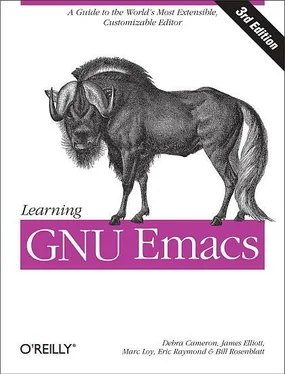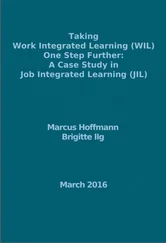Debra Cameron - Learning GNU Emacs, 3rd Edition
Здесь есть возможность читать онлайн «Debra Cameron - Learning GNU Emacs, 3rd Edition» весь текст электронной книги совершенно бесплатно (целиком полную версию без сокращений). В некоторых случаях можно слушать аудио, скачать через торрент в формате fb2 и присутствует краткое содержание. Год выпуска: 2004, ISBN: 2004, Издательство: O'Reilly Media, Жанр: Программы, Программирование, на английском языке. Описание произведения, (предисловие) а так же отзывы посетителей доступны на портале библиотеки ЛибКат.
- Название:Learning GNU Emacs, 3rd Edition
- Автор:
- Издательство:O'Reilly Media
- Жанр:
- Год:2004
- ISBN:0-596-00648-9
- Рейтинг книги:3 / 5. Голосов: 1
-
Избранное:Добавить в избранное
- Отзывы:
-
Ваша оценка:
- 60
- 1
- 2
- 3
- 4
- 5
Learning GNU Emacs, 3rd Edition: краткое содержание, описание и аннотация
Предлагаем к чтению аннотацию, описание, краткое содержание или предисловие (зависит от того, что написал сам автор книги «Learning GNU Emacs, 3rd Edition»). Если вы не нашли необходимую информацию о книге — напишите в комментариях, мы постараемся отыскать её.
, 3rd Edition tells readers how to get started with the GNU Emacs editor. It is a thorough guide that will also "grow" with you: as you become more proficient, this book will help you learn how to use Emacs more effectively. It takes you from basic Emacs usage (simple text editing) to moderately complicated customization and programming.The third edition of
describes Emacs 21.3 from the ground up, including new user interface features such as an icon-based toolbar and an interactive interface to Emacs customization. A new chapter details how to install and run Emacs on Mac OS X, Windows, and Linux, including tips for using Emacs effectively on those platforms.
, third edition, covers:
• How to edit files with Emacs
• Using the operating system shell through Emacs
• How to use multiple buffers, windows, and frames
• Customizing Emacs interactively and through startup files
• Writing macros to circumvent repetitious tasks
• Emacs as a programming environment for Java, C++, and Perl, among others
• Using Emacs as an integrated development environment (IDE)
• Integrating Emacs with CVS, Subversion and other change control systems for projects with multiple developers
• Writing HTML, XHTML, and XML with Emacs
• The basics of Emacs Lisp
The book is aimed at new Emacs users, whether or not they are programmers. Also useful for readers switching from other Emacs implementations to GNU Emacs.
Learning GNU Emacs, 3rd Edition — читать онлайн бесплатно полную книгу (весь текст) целиком
Ниже представлен текст книги, разбитый по страницам. Система сохранения места последней прочитанной страницы, позволяет с удобством читать онлайн бесплатно книгу «Learning GNU Emacs, 3rd Edition», без необходимости каждый раз заново искать на чём Вы остановились. Поставьте закладку, и сможете в любой момент перейти на страницу, на которой закончили чтение.
Интервал:
Закладка:
Stallman is widely recognized as the founder of the free software movement, which was an important predecessor of the open source movement. Linux is now the most prominent example of open source software, and it falls under the GNU Public License or GPL (available online at http://www.gnu.org/copyleft/gpl.html). Stallman argues that much of Linux outside the kernel itself is GNU software and so he refers to it as GNU/Linux. All controversies aside, Stallman's contribution to the open source movement cannot be overestimated. GNU software and open source software distributed under the GPL are a mainstay for developers and computer users all over the world.
The FSF was created precisely to distribute programs under terms that encourage you to share, rather than hoard, software. The GPL is designed to prevent an unfortunately common practice—namely, a company taking public domain code, making a few modifications and bug fixes, and then copyrighting the modified version. Once a company does this, the program has essentially become private property and disappears from the public domain. Stallman formed the foundation because he finds this practice abhorrent. As he explains in the GNU Manifesto, "I cannot in good conscience sign a nondisclosure agreement or a software license agreement . . . So that I can continue to use computers without dishonor, I have decided to put together a sufficient body of free software so that I will be able to get along without any software that is not free." Elsewhere in the manifesto, Stallman calls sharing software the "fundamental act of friendship among programmers." Their software is free because it can be shared and will always be shareable—without restriction. FSF software is not under restrictive copyright laws, which Stallman objects to in principle. In fact, he coined the term copyleft to describe the FSF's sharable software base. [3] FSF programs such as Emacs are often distributed with commercial systems. Even in these cases, the General Public License guarantees your right to use and give away their programs without restriction. Of course, the license does not apply to other proprietary software with which GNU tools have been shipped.
Since GNU Emacs was first released, many other pieces of the GNU operating environment have fallen into place: C and C++ compilers ( gcc and g++ ), a very powerful debugger ( gdb ), substitutes for lexand yacc(called flex and bison , respectively), a Unix shell ( bash , which stands for "Bourne-Again Shell"), the Gimp (a graphics tool comparable to Adobe PhotoShop), GNOME (a desktop environment for Linux), and many other programs and libraries. Many important open source projects that originally used variants of the GPL or other licensing schemes have adopted the GPL as their license, including Python, Mozilla, and Zope. Author David Wheeler argues that all open source projects should release their software under a GPL-compatible license [4] GPL-compatible is a critical distinction for many organizations. As our reviewer Mike Trent points out, many organizations release their software under a modified GPL because the GPL's license is actually "viral." That is, if one line of GPL'd code appears in a project, the entire project must be GPL'd. This means corporations interested in protecting their assets but still wanting to share code with the open source community cannot use the GPL without some modification.
(see http://www.dwheeler.com/essays/gpl-compatible.html for his views and some statistics about GPL'd software). With Linux, GNU tools, and other GPL'd software, it's possible to have a complete operating environment consistent with the values set forth by the FSF.
An Approach to Learning Emacs
This book is designed to get you started with Emacs as quickly as possible, whether you are an experienced computer user or a novice. The first two chapters give you the basics you need to know, and the rest of the book builds on these basics. After the first two chapters, you don't have to read the rest consecutively; you can skip to the topics that interest you. Additionally, the book is designed to give you just the level of hand-holding you want; you can either read the book in detail or skim it, looking for tables of commands and examples.
Here are some reading paths you could take:
| If | Read |
|---|---|
| You are a casual user | Preface, Chapter 1 Chapter 1. Emacs Basics Some of you out there are probably dying to get your hands on the keyboard and start typing. We won't try to stop you; turn to the section called "Starting Emacs" and you can go ahead. But do read the beginning of this chapter later when you're ready for a break. Emacs is much easier to learn if you understand some of the basic concepts involved, which we discuss in the following introduction.- Chapter 3 Chapter 3. Search and Replace The commands we discussed in the first two chapters are enough to get you started, but they're certainly not enough to do any serious editing. If you're using Emacs for anything longer than a few paragraphs, you'll want the support this chapter describes. In this chapter, we cover the various ways that Emacs lets you search for and replace text. Emacs provides the traditional search and replace facilities you would expect in any editor; it also provides several important variants, including incremental searches, regular expression searches, and query-replace. We also cover spell-checking here, because it is a type of replacement (errors are sought and replaced with corrections). Finally, we cover word abbreviation mode; this feature is a type of automatic replacement that can be a real timesaver., Chapter 14 Chapter 14. The Help System Emacs has the most comprehensive help facility of any text editor—and one of the best such facilities of any program at all. In fact, the Emacs help facilities probably cut down the time it took for us to write this book by an order of magnitude, and they can help you immeasurably in your ongoing quest to learn more about Emacs. In this chapter, we describe Emacs help in the following areas: • The tutorial. • The help key ( C-h ) and Help menu, which allow you to get help on a wide variety of topics. • The help facilities of complex commands like query-replace and dired . • Navigating Emacs manuals and using the info documentation reader. • Completion , in which Emacs helps you finish typing names of functions, variables, filenames, and more. Completion not only saves you time and helps you complete names of functions you know about but can help you discover new commands and variables. |
| You are a programmer or system administrator | Preface, Chapter 1 Chapter 1. Emacs Basics Some of you out there are probably dying to get your hands on the keyboard and start typing. We won't try to stop you; turn to the section called "Starting Emacs" and you can go ahead. But do read the beginning of this chapter later when you're ready for a break. Emacs is much easier to learn if you understand some of the basic concepts involved, which we discuss in the following introduction.- Chapter 5 Chapter 5. Emacs as a Work Environment Many of the everyday things you do from a command prompt can be done from within Emacs. You can execute commands, work with directories, and print files—all without leaving Emacs. Changing tasks is as simple as jumping between buffers. What's important about this? Of course, it's nice to be able to move between tasks easily. What's even more important is that you have the same editing environment no matter what you're doing: you can use all of the Emacs editing commands to work on a file, give shell commands, then start up Dired, the directory editor, to do some file maintenance. It is simple to move text from one window to another. You can execute a command and then use Emacs commands to cut and paste the results into a file. If you're trying to compile a program and keep getting error messages, you can save the interactive session as a file and confer with someone about the problem. Despite the many advantages of modern window systems, Emacs often provides the best way to integrate the many kinds of work you do daily. Much of the information in this chapter involves integration between Emacs and the operating system. Emacs is most commonly a Unix editor, so forgive us for a bias in that direction. But we are happy to report that for users of GNU Emacs on other platforms, integration with the operating system is still available; you can use shell mode to run commands and can edit directories with Dired. There's no reason to leave Emacs no matter what your platform is., Chapter 9- Chapter 12 |
| You are a writer or production person | Preface, Chapter 1 Chapter 1. Emacs Basics Some of you out there are probably dying to get your hands on the keyboard and start typing. We won't try to stop you; turn to the section called "Starting Emacs" and you can go ahead. But do read the beginning of this chapter later when you're ready for a break. Emacs is much easier to learn if you understand some of the basic concepts involved, which we discuss in the following introduction.- Chapter 3 Chapter 3. Search and Replace The commands we discussed in the first two chapters are enough to get you started, but they're certainly not enough to do any serious editing. If you're using Emacs for anything longer than a few paragraphs, you'll want the support this chapter describes. In this chapter, we cover the various ways that Emacs lets you search for and replace text. Emacs provides the traditional search and replace facilities you would expect in any editor; it also provides several important variants, including incremental searches, regular expression searches, and query-replace. We also cover spell-checking here, because it is a type of replacement (errors are sought and replaced with corrections). Finally, we cover word abbreviation mode; this feature is a type of automatic replacement that can be a real timesaver., Chapter 7, Chapter 8, Chapter 14 Chapter 14. The Help System Emacs has the most comprehensive help facility of any text editor—and one of the best such facilities of any program at all. In fact, the Emacs help facilities probably cut down the time it took for us to write this book by an order of magnitude, and they can help you immeasurably in your ongoing quest to learn more about Emacs. In this chapter, we describe Emacs help in the following areas: • The tutorial. • The help key ( C-h ) and Help menu, which allow you to get help on a wide variety of topics. • The help facilities of complex commands like query-replace and dired . • Navigating Emacs manuals and using the info documentation reader. • Completion , in which Emacs helps you finish typing names of functions, variables, filenames, and more. Completion not only saves you time and helps you complete names of functions you know about but can help you discover new commands and variables. |
| You want to customize Emacs | Chapter 10and possibly Chapter 11 |
| You write HTML or XML | Preface, Chapter 1 Chapter 1. Emacs Basics Some of you out there are probably dying to get your hands on the keyboard and start typing. We won't try to stop you; turn to the section called "Starting Emacs" and you can go ahead. But do read the beginning of this chapter later when you're ready for a break. Emacs is much easier to learn if you understand some of the basic concepts involved, which we discuss in the following introduction.- Chapter 3 Chapter 3. Search and Replace The commands we discussed in the first two chapters are enough to get you started, but they're certainly not enough to do any serious editing. If you're using Emacs for anything longer than a few paragraphs, you'll want the support this chapter describes. In this chapter, we cover the various ways that Emacs lets you search for and replace text. Emacs provides the traditional search and replace facilities you would expect in any editor; it also provides several important variants, including incremental searches, regular expression searches, and query-replace. We also cover spell-checking here, because it is a type of replacement (errors are sought and replaced with corrections). Finally, we cover word abbreviation mode; this feature is a type of automatic replacement that can be a real timesaver., Chapter 8 |
| You want to use operating system commands in Emacs | Chapter 5 Chapter 5. Emacs as a Work Environment Many of the everyday things you do from a command prompt can be done from within Emacs. You can execute commands, work with directories, and print files—all without leaving Emacs. Changing tasks is as simple as jumping between buffers. What's important about this? Of course, it's nice to be able to move between tasks easily. What's even more important is that you have the same editing environment no matter what you're doing: you can use all of the Emacs editing commands to work on a file, give shell commands, then start up Dired, the directory editor, to do some file maintenance. It is simple to move text from one window to another. You can execute a command and then use Emacs commands to cut and paste the results into a file. If you're trying to compile a program and keep getting error messages, you can save the interactive session as a file and confer with someone about the problem. Despite the many advantages of modern window systems, Emacs often provides the best way to integrate the many kinds of work you do daily. Much of the information in this chapter involves integration between Emacs and the operating system. Emacs is most commonly a Unix editor, so forgive us for a bias in that direction. But we are happy to report that for users of GNU Emacs on other platforms, integration with the operating system is still available; you can use shell mode to run commands and can edit directories with Dired. There's no reason to leave Emacs no matter what your platform is. |
| You use Emacs on Windows or Mac OS X | Chapter 13 |
These reading paths are offered only as a guideline. Emacs is one gigantic, functionally rich editor. We've divided it up into digestible bites for you, so you don't have to be put off by its size and scope. The best way to learn Emacs is incrementally; learn a little now, then learn more features as you get curious about them. If you need to do something and don't know how to do it in Emacs, Emacs probably already does it; if it doesn't, you can learn how to write a Lisp function to add it to Emacs (see Chapter 11for details). The online help system is an excellent place to learn about new features on the fly; online help is discussed in Chapter 1 Chapter 1. Emacs Basics Some of you out there are probably dying to get your hands on the keyboard and start typing. We won't try to stop you; turn to the section called "Starting Emacs" and you can go ahead. But do read the beginning of this chapter later when you're ready for a break. Emacs is much easier to learn if you understand some of the basic concepts involved, which we discuss in the following introduction.
and in more detail in Chapter 14 Chapter 14. The Help System Emacs has the most comprehensive help facility of any text editor—and one of the best such facilities of any program at all. In fact, the Emacs help facilities probably cut down the time it took for us to write this book by an order of magnitude, and they can help you immeasurably in your ongoing quest to learn more about Emacs. In this chapter, we describe Emacs help in the following areas: • The tutorial. • The help key ( C-h ) and Help menu, which allow you to get help on a wide variety of topics. • The help facilities of complex commands like query-replace and dired . • Navigating Emacs manuals and using the info documentation reader. • Completion , in which Emacs helps you finish typing names of functions, variables, filenames, and more. Completion not only saves you time and helps you complete names of functions you know about but can help you discover new commands and variables.
.
Интервал:
Закладка:
Похожие книги на «Learning GNU Emacs, 3rd Edition»
Представляем Вашему вниманию похожие книги на «Learning GNU Emacs, 3rd Edition» списком для выбора. Мы отобрали схожую по названию и смыслу литературу в надежде предоставить читателям больше вариантов отыскать новые, интересные, ещё непрочитанные произведения.
Обсуждение, отзывы о книге «Learning GNU Emacs, 3rd Edition» и просто собственные мнения читателей. Оставьте ваши комментарии, напишите, что Вы думаете о произведении, его смысле или главных героях. Укажите что конкретно понравилось, а что нет, и почему Вы так считаете.












